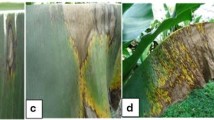Abstract
Black leaf streak (black Sigatoka) caused by Pseudocercospora fijiensis (teleomorph Mycosphaerella fijiensis) is the most destructive leaf disease of banana world-wide. It is capable of destroying plantations unless controlled and successful commercial production is dependent on frequent applications of fungicides. A study was made to determine whether the pathogen is capable of infecting the fruit of ‘Cavendish’ banana and completing its life cycle on banana skin as the sole substrate. Emerging and recently emerged bunches of ‘Cavendish’ banana were inoculated in the field with carbendazim-resistant strains of P. fijiensis, incubated in situ in a humid environment for 6 days and then allowed to develop and mature naturally. The fruit were harvested approximately 16 weeks after inoculation, ripened to green tip stage, and skins incubated either as whole skins in humid containers or as thin strips of skin removed from the fruit and incubated on water agar modified with penicillin, streptomycin and carbendazim in Petri dishes. Supradermal fascicles of P. fijiensis were found on the incubated skin strips and whole skins within 5 days. From a total of approximately 300 field inoculated fruit, 18 colonies of P. fijiensis were detected. Small pieces of skin, each supporting a single fascicle, were excised, incubated individually on modified water agar and monitored for the production of conidia. It was shown that the fungus colonised, and was able to sporulate profusely on the excised skin pieces. This finding has implications for the transfer of strains of P. fijiensis between countries via commercial banana shipments and represents a potential pathway of entry to countries currently free of the disease.







Similar content being viewed by others
References
Balint-Kurti, P. J., May, G. D., & Churchill, A. C. L. (2001). Development of a transformation system for Mycosphaerella pathogens of banana: a tool for the study of host/pathogen interactions. FEMS Microbiology Letters, 195, 9–15.
Cedeno, L., Carrero, C., & Quintero, K. (2000). Identification of Mycosphaerella fijiensis as cause of specks on fruits of plantain cv. Harton in Venezuela (Identificacion de Mycosphaerella fijiensis como causa de "pecas" en frutos de platano cv. Harton en Venezuela). Fitopatologia Venezolana, 13, 6–10.
Churchill, A. C. L. (2011). Mycosphaerella fijinensis, the black leaf streak pathogen of banana: progress towards understanding pathogen biology and detection, disease development, and the challenges of control. Molecular Plant Pathology, 12, 307–328.
Etebu, E., Pasberg-Gauhl, C., Gauhl, F., & Daniel-Kalio, L. A. (2003). Preliminary studies of in vitro stimulation of sexual mating among isolates of Mycosphaerella fijiensis, causal agent of black Sigatoka disease in bananas and plantains. Phytoparasitica, 31, 69–75.
Fullerton, R.A., & Casonato S.G. (2009). Detection of Mycosphaerella fijiensis in the skin of 'Cavendish' banana. Australasian Plant Pathology Society APPS 2009 Plant Health Management: An Integrated Approach, 2009. Newcastle, Australia, 150.
Fullerton, R. A., & Tracey, G. M. (1984). Tolerance of Mycosphaerella fijiensis to benomyl and carbendazim in the Pacific Islands. Tropical Agriculture, 61, 133–136.
Gauhl, F. (1993). Some aspects of black Sigatoka epidemiology in Central America and outlook for future research in subSaharan Africa. In C. S. Gold & B. Gemmill (Eds.), Biological and Integrated Control of Highland Banana and Plantain Pests and Diseases: Proceedings of a Research Coordination Meeting, held at Cotonou, Benin 12-14 November 1991 (pp. 276–289).
Hanada, R. E., Gasparotto, L., & Pereira, J. C. R. (2002). Conidium survival of Mycosphaerella fijiensis on different materials. Fitopatologia Brasileira, 27, 408–411.
Henderson, J. (Ed). (2006). Sigatoka leaf spot disease on banana laboratory diagnostics manual. Plant Health Australia.
Hernandez, Y., Portillo, F., Portillo, M., Navarro, C., Rodriguez, M., & Velazco, J. (2006). Stomatal density in plantain materials (Musa AAB, AAAB and ABB) susceptible and resistant to black Sigatoka (Mycosphaerella fijiensis, Morelet). Revista de la Facultad de Agronomia, Universidad del Zulia, 23, 294–300.
Hine, R. B., & Aragaki, M. (1963). Pathogenicity, vitamin nutrition and cultural characteristics of isolates of Phytophthora parasitica from carnation and other hosts in Hawaii. Phytopathology, 53, 1194–1197.
Johansen, A., & Jeger, M. J. (1993). Use of PCR for detection of Mycosphaerella fijiensis and M. musicola, the causal agents of Sigatoka leaf spots in banana and plantain. Mycological Research, 97, 670–674.
Jones, D. R. (Ed.). (2000). Diseases of banana, Abaca and Enset. UK: CABI Publishing.
Meredith, D. S., & Lawrence, J. S. (1969). Black leaf streak of bananas (Mycosphaerella fijiensis): symptoms of disease in Hawaii, and notes on the condial state of the causal fungus. Transactions of the British Mycological Society, 52, 459–476.
Meredith, D. S., Lawrence, J. S., & Firman, I. D. (1973). Ascospore release and dispersal in black leaf streak disease of bananas (Mycosphaerella fijiensis). Transactions of the British Mycological Society, 60, 547–554.
Acknowledgements
The authors wish to thank the Tonga Ministry of Agriculture, Fisheries, Food and Forests (MAFFF) for allowing access to the banana plantation and the laboratory facilities of Vaini Research Station. We also thank the MAFFF plant pathology staff Luseane Taufa, Losaline Tufunga, Waikato ‘Aholelei and Aki Vea for their technical support, particularly during the assessments of the fruit. Without their assistance this work would not have been possible.
Author information
Authors and Affiliations
Corresponding author
Ethics declarations
This paper reports original research by the authors which has not been published elsewhere nor submitted for publication elsewhere.
Conflict of interest
The authors declare they have no conflicts of interest in the presentation of this work.
Research involving human participants and/or animals
No human participants nor animals were involved with this research.
Informed consent
Not relevant to this work.
Rights and permissions
About this article
Cite this article
Fullerton, R.A., Casonato, S.G. The infection of the fruit of ‘Cavendish’ banana by Pseudocercospora fijiensis, cause of black leaf streak (black Sigatoka). Eur J Plant Pathol 155, 779–787 (2019). https://doi.org/10.1007/s10658-019-01807-x
Accepted:
Published:
Issue Date:
DOI: https://doi.org/10.1007/s10658-019-01807-x




